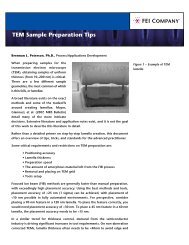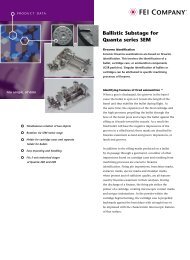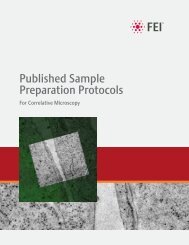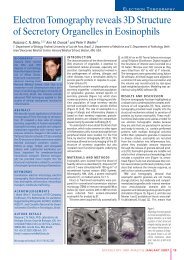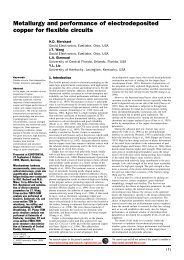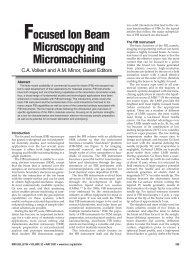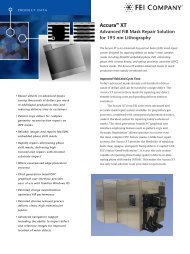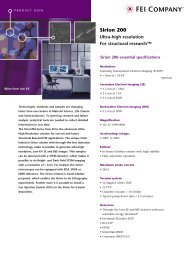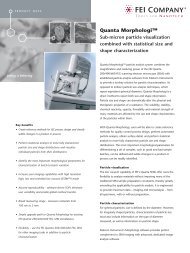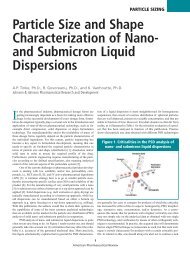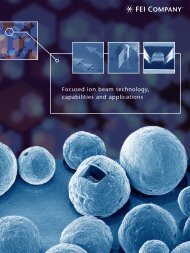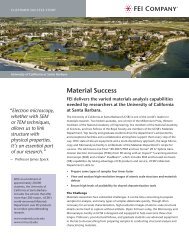Wet STEM: A newdevelopment in environmental SEM for imaging ...
Wet STEM: A newdevelopment in environmental SEM for imaging ...
Wet STEM: A newdevelopment in environmental SEM for imaging ...
Create successful ePaper yourself
Turn your PDF publications into a flip-book with our unique Google optimized e-Paper software.
wet samples and dynamic imag<strong>in</strong>g <strong>in</strong> a chang<strong>in</strong>g<br />
sample environment, as it is reported <strong>in</strong> Ref. [1].<br />
For this reason, traditional microstructural characterization<br />
of delicate samples usually requires a<br />
prelim<strong>in</strong>ary preparation step, <strong>in</strong>clud<strong>in</strong>g fix<strong>in</strong>g and<br />
sta<strong>in</strong><strong>in</strong>g. E<strong>SEM</strong> differs from a conventional <strong>SEM</strong><br />
s<strong>in</strong>ce the sample is not viewed under high vacuum.<br />
The column is divided <strong>in</strong>to differential pressure<br />
zones that allows the electron gun to rema<strong>in</strong> under<br />
high vacuum while the sample chamber conta<strong>in</strong>s a<br />
fewtorr of gas. Collisions between electrons and<br />
gas molecules produce positive ions that prevent<br />
the build-up of charges on <strong>in</strong>sulat<strong>in</strong>g samples. This<br />
consequently elim<strong>in</strong>ates the need <strong>for</strong> a conductive<br />
surface coat<strong>in</strong>g on <strong>in</strong>sulators surfaces. Moreover,<br />
daughter electrons are produced thanks to a<br />
‘cascade effect’ that amplifies the signal detected<br />
by the positively biased <strong>environmental</strong> detector.<br />
Eventually, when the microscope is equipped with<br />
a Peltier stage, the adjustable chamber pressure<br />
and temperature ranges enable the observation of<br />
wet samples <strong>in</strong> their natural state. For all these<br />
reasons, E<strong>SEM</strong> appears to be an ideal technique to<br />
study all k<strong>in</strong>ds of wet nano-objects.<br />
The observation of wet organic samples with<br />
E<strong>SEM</strong> has already been reported <strong>in</strong> the literature<br />
[1–3]. In all cases, special attention is recommended<br />
<strong>in</strong> order to m<strong>in</strong>imize evaporation dur<strong>in</strong>g<br />
the pump down sequence [4]. Then, the ma<strong>in</strong><br />
difficulty that restricts observation dur<strong>in</strong>g imag<strong>in</strong>g<br />
is the fast sample damage under the <strong>in</strong>cident<br />
electron beam. In the case of polymers, the<br />
degradation may be accelerated <strong>in</strong> the presence<br />
of water because of the high mobility of radicals<br />
through the water layer, which <strong>in</strong>creases the rate of<br />
hydrolysis [2]. This prevents the successive imag<strong>in</strong>g<br />
of the same area, and also limits the imag<strong>in</strong>g<br />
magnification—higher magnification means higher<br />
irradiation dose and there<strong>for</strong>e more damage.<br />
F<strong>in</strong>ally, one should keep <strong>in</strong> m<strong>in</strong>d that only the<br />
top layer of the sample surface is revealed, which<br />
means that classical use of E<strong>SEM</strong> does not allow<br />
the observation of samples deep <strong>in</strong>side the liquid<br />
layer.<br />
This paper presents, a new‘‘wet <strong>STEM</strong>’’ device<br />
developed <strong>for</strong> the transmission imag<strong>in</strong>g of suspensions—i.e.<br />
objects from a fewnm to several mm<br />
stabilized <strong>in</strong> a liquid phase, latices (<strong>in</strong> polymer<br />
ARTICLE IN PRESS<br />
A. Bogner et al. / Ultramicroscopy 104 (2005) 290–301 291<br />
science term<strong>in</strong>ology, latex means a colloidal<br />
suspension of polymer particles <strong>in</strong> an aqueous<br />
solution) or emulsions (droplets of liquid dispersed<br />
<strong>in</strong> another liquid phase). Thanks to its development<br />
<strong>in</strong> an E<strong>SEM</strong>, it is a straight-<strong>for</strong>ward analysis<br />
technique. Its application is illustrated through<br />
several cases: organic and <strong>in</strong>organic objects,<br />
monomer and polymer emulsions. For sake of<br />
clarity <strong>in</strong> the experimental description, the term<br />
‘‘suspension’’ is used <strong>for</strong> all the samples imaged.<br />
2. Experimental device<br />
The observations have been per<strong>for</strong>med with a<br />
FEI XL 30 FEG E<strong>SEM</strong>. The specific device<br />
developed <strong>for</strong> imag<strong>in</strong>g wet samples <strong>in</strong> transmission<br />
mode, and hereafter called ‘‘wet <strong>STEM</strong>’’, is<br />
described <strong>in</strong> Fig. 1.<br />
2.1. Experimental setup<br />
A TEM copper grid is placed on the head of a<br />
TEM sample holder, which is fixed on a round<br />
Fig. 1. Schematic of the wet <strong>STEM</strong> device <strong>for</strong> annular darkfield<br />
imag<strong>in</strong>g. (a) Peltier stage, (b) <strong>SEM</strong> mount support<strong>in</strong>g the<br />
latex droplet on a TEM grid, (c) solid-state detector, usually<br />
used <strong>for</strong> the collection of BSE, removed from its position and<br />
located belowthe specimen and (i) Convergent <strong>in</strong>cident beam.<br />
Remark: the direct transmitted beam is not collected.



